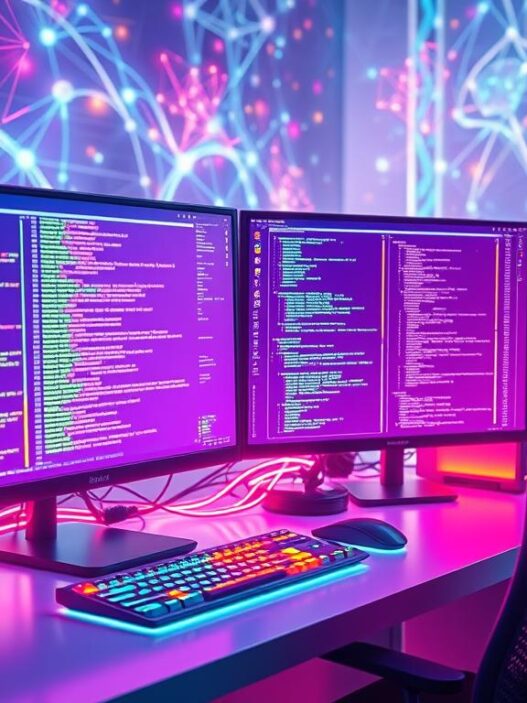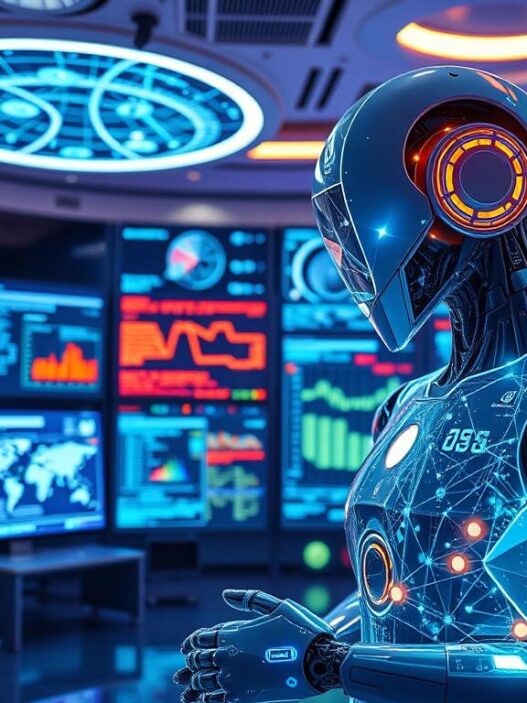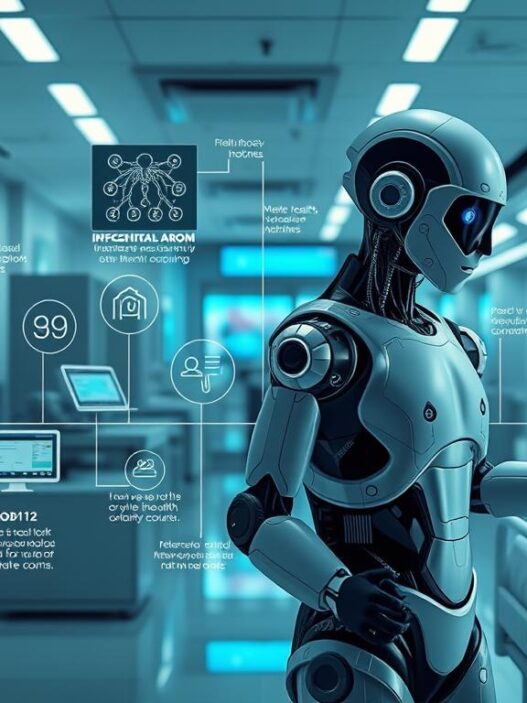Setting off on a journey through artificial intelligence, we find the key role of multimodal neurons. They are vital for neural network cognition. These neurons mix different sensory information, marking a big step in AI cognitive layers. On March 4, 2021, a breakthrough showed how AIs might work like human brains by using multimodal neural connections1. This opens doors for smarter AI that understand more about artificial intelligence insights.
Exploring the secrets of AI cognition, we look at a crucial study on multimodal neurons. This research brings together different user interactions and academic work. People like Imnimo and sendtown_expwy discuss its impact. They talked on March 5, 2021, about how these neurons can change technology1.
Key Takeaways
- Multimodal neurons operate as the brain’s equivalent, cross-referencing and binding together data from disparate sensory inputs.
- The research unearths the potential for AI systems to achieve a semblance of human-like perception and cognition.
- CLIP, through rigorous training on over 400 million text-image pairs, has sharpened AI’s zero-shot learning capabilities fourfold2.
- Understanding neuron categorization within artificial networks can unravel the biases and ambiguities entrenched in these systems3.
- With multimodal neurons, AI’s lexicon is vastly expanding, bridging the gap between language and visual understanding2.
Discovering Multimodal Neurons: A Glimpse into AI’s Cognitive Layers
Studying how multimodal neurons began in AI is a huge step in learning about deep learning. Gabriel Goh led this amazing find. It helps us understand complex neural structures that are like our brain’s workings.
Origins of Multimodal Neurons in Deep Learning
Top schools like the University of Cambridge, Oxford, and MIT played a big part in this area4. They worked together from all over the world. Their methods encouraged more study into how AI can mirror how we think4.
The Breakthrough: How Gabriel Goh’s Team Unearthed Multimodal Insights
Jascha Achterberg and Katie Collins led a deep dive into what makes neural networks tick4. They found ties between new AI and brain scan tech. It shows how well AI can copy the brain’s complex activities5.
Defining Multimodal Neurons: Understanding the Complex Structures
Our grasp of multimodal neurons grew with a closer look at how neural networks learn4. AI and brain science working together has really pushed the envelope. This teamwork has sparked new ideas for AI design5.
Big leaps in understanding AI and our brains are changing the game. This not only makes us smarter about AI’s skills but also opens doors for new tools in many areas. It hints at what’s next for AI tech.
The Role of CLIP in Advancing Neural Network Potentials
The CLIP framework, created by Alec Radford, marks a big leap in advanced neural networks. It boosts the power of visual learning AI. It does this by better understanding complex visual and text data at the same time. CLIP can look at pics and words together, leading to big improvements in AI systems.
Adding the CLIP framework to advanced neural networks helps solve complex problems during training. This is especially true for multimodal learning situations6. Radford’s study shows how CLIP mixes language and visuals. This mix helps AI learn about human thinking in new ways.
Using CLIP in neural networks is very useful. It helps AI systems do hard tasks like spotting tricky text attacks or understanding complex data interactions. As CLIP framework grows, it stays crucial for improving visual learning AI.

The CLIP model is great for many areas, like checking health images, guiding self-driving cars, and making learning programs just for you. Advanced neural networks power these smart AI systems. These systems can see and think a bit like us.
To sum up, CLIP’s use in AI is a huge step forward. It makes visual learning AI better and opens new paths for AI progress. This move is key for future AI breakthroughs.
Visualizing Multimodal Neuron Functions and Interactions
The study of how neurons work together has grown a lot thanks to new tech. These advancements help us map the brain’s activities and understand its complex patterns. This knowledge is key to making AI think more like humans.
Faceted Feature Visualization: A New Path to Interpretability
Feature visualization is essential for understanding how AI thinks. It shows us what happens inside AI by displaying how neurons react to various inputs. Studies, like those mentioned in this article, prove it helps us get why and how neurons behave the way they do.
Neuron Atlases: Mapping AI’s Complex Representations
Creating neuron maps shows us how AI’s brain works and how its parts interact. These detailed guides are like treasure maps. They show researchers the routes making up AI’s thought process and how it understands the world. This mapping is vital for improving AI by pinpointing where changes are needed.
Multimodal Activation Atlases: Exploring the Fusion of Sights and Language
Multimodal activation atlases let us see how AI combines sight and words. They offer insights into how images and text come together in AI systems. This is important for building AIs that can navigate our complex, sensory-rich world.
Besides pictures, data helps us get these complicated networks. For instance, many neurons work with more than one sensory input, linking different senses together7. Techniques like clustering, which groups similar neurons, help clear up these dense visuals8. These methods make the huge amount of data easier to understand.
| Feature | Percentage | Impact on AI Interpretability |
|---|---|---|
| Multimodal Neurons | 80% | Enhances sensory integration |
| Unimodal Neurons | 18% | Specializes in single sensory modality |
| Neural Clustering Usage | Widely employed | Reduces visual clutter, enhances pattern recognition |
This deep look into AI’s workings sets the stage for future improvements. It also helps us understand how machines might one day mimic the complexity of human senses, pushing the boundaries in robotics and how computers think.
Cross-Referencing Human Neuroscience: Parallels and Differences
The field of neuroscience and artificial intelligence (AI) merge in exciting ways. They both study the brain and AI systems. We see similar patterns in neuron functions when looking at brain science and AI. These comparisons give us a special view to examine both our likenesses and differences.

Starting off, we compare how brains and digital systems process information. The Bridging-Vision-and-Language (BriVL) model uses big data, similar to our brain’s complex networks. It learns by linking images and texts in a way that mirrors how our brains work9.
Comparisons also touch on theory. Thinkers from Hebb D.O. to AI experts like Yann LeCun have found basic similarities. Hebb’s ideas on behavior and brain connections help both brain science and AI10.
But, the differences are just as interesting. When comparing humans and AI, we see unique aspects of human thought. Emotions and unpredictable thoughts are hard for AI to copy perfectly. Even top models like OpenAI CLIP have their limits, lacking the spontaneous nature of humans9.
Looking at neural cognition highlights how unique human intelligence is. It also shows the potential and limits of AI. By studying how neurons work in AI, we learn valuable lessons for improving AI. These lessons aim to make AI as complex and capable as the human brain.
Multimodal neurons in artificial neural networks
Multimodal neurons have truly advanced artificial intelligence. They are key in broadening AI’s language understanding and processing both language and images. These neurons help in connecting with complex datasets that include text and sound.
Expanding AI’s Lexicon: How Multimodal Neurons Decode Language and Images
These neurons pull together sensory data to enhance AI in areas such as autonomous driving and healthcare. For example, autonomous cars use these neurons to better spot obstacles and navigate. They combine visual, lidar, and sensor data11. In healthcare, these neurons help by mixing different types of data. This includes images, DNA information, and patient records. This leads to better, personalized care plans11.
Deeper Dive: Typographical Attacks and Their Implications for Neuron Robustness
However, multimodal neurons are not perfect. They can be tricked by typographical attacks. This shows we need to make these neurons stronger. An example is the Stroop effect, where the color of words can confuse neurons. It shows we must keep working to protect AI12.
Regional Neurons vs. Multimodal Neurons: A Comparative Analysis
When we compare regional and multimodal neurons, the differences are clear. Mainly, regional neurons process data from one area. This makes them less adaptable than multimodal neurons. Multimodal neurons can handle diverse data types. This ability makes AI more precise and detailed in tasks like recommending content and editing videos11.
Conclusion
Studying multimodal neurons has shown us a deep layer in AI neural progress. It shows us how important multimodal neuron significance is in copying human thinking. Studies, like one in 2013 on medical diagnosis, showed AI can sort complex info well13. These networks affect many areas, from space studies to city planning13, mental wellness, and crime solving. They help with stuff like brain wave studies and spotting faces13.
Looking ahead, the future of artificial neural networks seems big. They are getting better at jobs that need seeing and understanding language. This helps with self-driving cars and better medical tests11. Yet, there are hurdles in mixing different kinds of data. More research could help get past these issues and make these networks work better11.
Continuous improvements signal a booming age for AI uses, grounded by experts like Gabriel Goh and Alec Radford. Their work helps mix AI with human-like thinking14. Talking about multimodal neurons isn’t just science talk; it’s a light leading us to a future where smart machines interact with our world in new ways14.




















